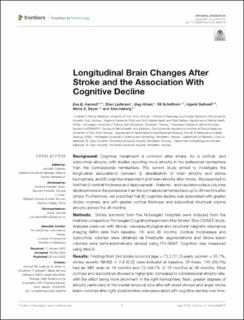| dc.description.abstract | Background: Cognitive impairment is common after stroke. So is cortical- and subcortical atrophy, with studies reporting more atrophy in the ipsilesional hemisphere than the contralesional hemisphere. The current study aimed to investigate the longitudinal associations between (I) lateralization of brain atrophy and stroke hemisphere, and (II) cognitive impairment and brain atrophy after stroke. We expected to find that (I) cortical thickness and hippocampal-, thalamic-, and caudate nucleus volumes declined more in the ipsilesional than the contralesional hemisphere up to 36 months after stroke. Furthermore, we predicted that (II) cognitive decline was associated with greater stroke volumes, and with greater cortical thickness and subcortical structural volume atrophy across the 36 months.
Methods: Stroke survivors from five Norwegian hospitals were included from the multisite-prospective “Norwegian Cognitive Impairment After Stroke” (Nor-COAST) study. Analyses were run with clinical, neuropsychological and structural magnetic resonance imaging (MRI) data from baseline, 18- and 36 months. Cortical thicknesses and subcortical volumes were obtained via FreeSurfer segmentations and stroke lesion volumes were semi-automatically derived using ITK-SNAP. Cognition was measured using MoCA.
Results: Findings from 244 stroke survivors [age = 72.2 (11.3) years, women = 55.7%, stroke severity NIHSS = 4.9 (5.0)] were included at baseline. Of these, 145 (59.4%) had an MRI scan at 18 months and 72 (49.7% of 18 months) at 36 months. Most cortices and subcortices showed a higher ipsi- compared to contralesional atrophy rate, with the effect being more prominent in the right hemisphere. Next, greater degrees of atrophy particularly in the medial temporal lobe after left-sided strokes and larger stroke lesion volumes after right-sided strokes were associated with cognitive decline over time.
Conclusion: Atrophy in the ipsilesional hemisphere was greater than in the contralesional hemisphere over time. This effect was found to be more prominent in the right hemisphere, pointing to a possible higher resilience to stroke of the left hemisphere. Lastly, greater atrophy of the cortex and subcortex, as well as larger stroke volume, were associated with worse cognition over time and should be included in risk assessments of cognitive decline after stroke. | en_US |

